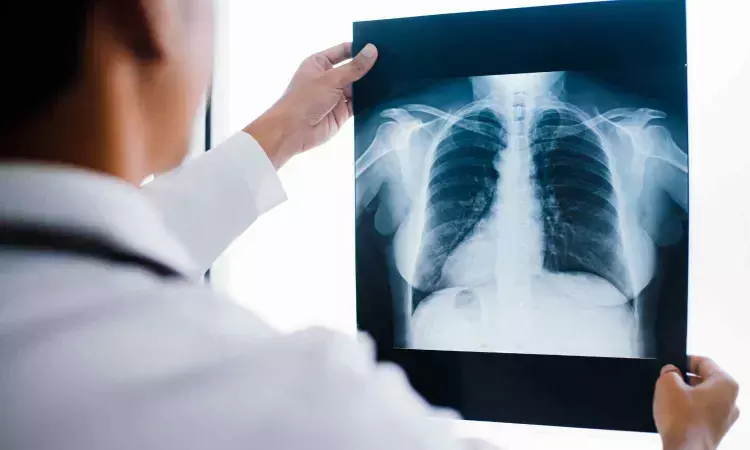- Home
- Medical news & Guidelines
- Anesthesiology
- Cardiology and CTVS
- Critical Care
- Dentistry
- Dermatology
- Diabetes and Endocrinology
- ENT
- Gastroenterology
- Medicine
- Nephrology
- Neurology
- Obstretics-Gynaecology
- Oncology
- Ophthalmology
- Orthopaedics
- Pediatrics-Neonatology
- Psychiatry
- Pulmonology
- Radiology
- Surgery
- Urology
- Laboratory Medicine
- Diet
- Nursing
- Paramedical
- Physiotherapy
- Health news
- Fact Check
- Bone Health Fact Check
- Brain Health Fact Check
- Cancer Related Fact Check
- Child Care Fact Check
- Dental and oral health fact check
- Diabetes and metabolic health fact check
- Diet and Nutrition Fact Check
- Eye and ENT Care Fact Check
- Fitness fact check
- Gut health fact check
- Heart health fact check
- Kidney health fact check
- Medical education fact check
- Men's health fact check
- Respiratory fact check
- Skin and hair care fact check
- Vaccine and Immunization fact check
- Women's health fact check
- AYUSH
- State News
- Andaman and Nicobar Islands
- Andhra Pradesh
- Arunachal Pradesh
- Assam
- Bihar
- Chandigarh
- Chattisgarh
- Dadra and Nagar Haveli
- Daman and Diu
- Delhi
- Goa
- Gujarat
- Haryana
- Himachal Pradesh
- Jammu & Kashmir
- Jharkhand
- Karnataka
- Kerala
- Ladakh
- Lakshadweep
- Madhya Pradesh
- Maharashtra
- Manipur
- Meghalaya
- Mizoram
- Nagaland
- Odisha
- Puducherry
- Punjab
- Rajasthan
- Sikkim
- Tamil Nadu
- Telangana
- Tripura
- Uttar Pradesh
- Uttrakhand
- West Bengal
- Medical Education
- Industry
AI Matches Radiologists in Detecting TB and Chest X-Ray Abnormalities, Finds Multi-Site Study

USA: In a significant step toward enhancing tuberculosis (TB) screening efforts, a recent multi-site prospective study has validated the use of artificial intelligence (AI) for detecting active pulmonary TB and other chest X-ray (CXR) abnormalities. Conducted in settings with high TB and HIV prevalence, the study found that AI tools performed comparably to radiologists in triaging suspected TB cases.
"AI matched the performance of radiologists in detecting active tuberculosis and also showed promise in identifying other chest X-ray abnormalities effectively," the researchers wrote in NEJM AI.
To enhance TB screening in resource-limited settings, researchers explored using artificial intelligence to interpret chest X-rays as a potential triage tool for active pulmonary tuberculosis. Sahar Kazemzadeh, Google, Mountain View, CA, and colleagues aimed to evaluate the effectiveness of a commercially available CXR-based AI system in detecting active TB in real-world clinical settings.
For this purpose, the researchers assessed two cloud-based chest X-ray AI tools—one for detecting tuberculosis and the other for identifying general CXR abnormalities—in a high-TB and HIV burden population. The study included 1,978 adults with TB symptoms, recent TB exposure, or newly diagnosed HIV across three clinical sites.
The TB AI scores were evaluated using two thresholds: one for high sensitivity and another to mirror radiologist performance. Ten radiologists reviewed the X-rays independently, blinded to the reference results. The primary aim was to test whether the TB AI was noninferior to radiologists, while secondary analyses compared its performance with WHO targets. The abnormality AI was also evaluated against triage-appropriate sensitivity and specificity benchmarks.
Key Findings:
- Among the 1,910 patients analyzed, 1,827 (96%) had a conclusive TB diagnosis. Of these, 649 patients (36%) were HIV positive, and 192 patients (11%) were TB positive.
- The TB AI demonstrated 87% sensitivity and 70% specificity at the high-sensitivity threshold.
- At the balanced threshold, the TB AI showed 78% sensitivity and 82% specificity.
- Radiologists had a mean sensitivity of 76% and a mean specificity of 82%.
- At the high-sensitivity threshold, TB AI was noninferior to the average radiologist's sensitivity but not to specificity.
- TB AI exceeded the WHO target for specificity but did not meet the sensitivity benchmark.
- At the balanced threshold, the performance of TB AI was comparable to that of radiologists.
- The abnormality AI achieved 97% sensitivity and 79% specificity, meeting both predefined performance targets.
The study concluded that the chest X-ray-based AI system for tuberculosis detection performed on par with radiologists when used for triaging active pulmonary TB in populations with high TB and HIV prevalence. However, neither the AI tool nor the radiologists met the World Health Organization's recommended sensitivity levels in this setting. The AI system also showed promise in identifying other chest X-ray abnormalities, highlighting its potential for broader clinical use.
Reference:
Kazemzadeh S, Kiraly AP, Nabulsi Z, Sanjase N, Maimbolwa M, Shuma B, Jamshy S, Chen C, Agharwal A, Lau CT, Sellergren A, Golden D, Yu J, Wu E, Matias Y, Chou K, Corrado GS, Shetty S, Tse D, Eswaran K, Liu Y, Pilgrim R, Muyoyeta M, Prabhakara S. Prospective Multi-Site Validation of AI to Detect Tuberculosis and Chest X-Ray Abnormalities. NEJM AI. 2024 Oct;1(10):10.1056/aioa2400018. doi: 10.1056/aioa2400018. Epub 2024 Sep 26. PMID: 39823016; PMCID: PMC11737584.
Dr Kamal Kant Kohli-MBBS, DTCD- a chest specialist with more than 30 years of practice and a flair for writing clinical articles, Dr Kamal Kant Kohli joined Medical Dialogues as a Chief Editor of Medical News. Besides writing articles, as an editor, he proofreads and verifies all the medical content published on Medical Dialogues including those coming from journals, studies,medical conferences,guidelines etc. Email: drkohli@medicaldialogues.in. Contact no. 011-43720751


